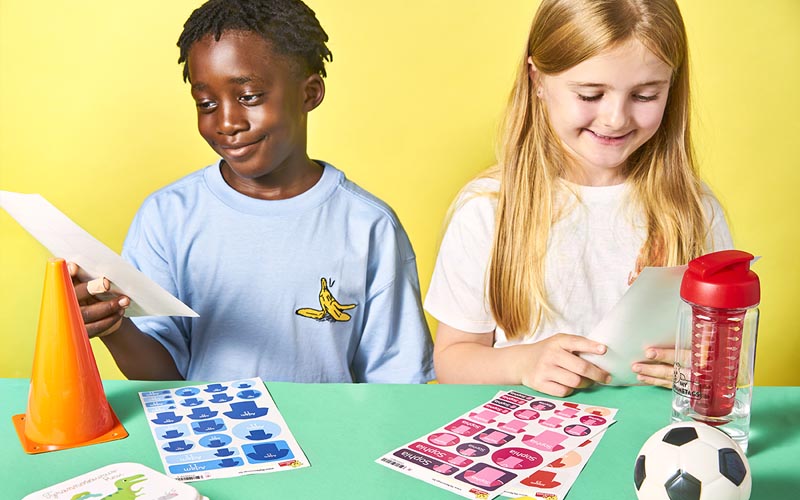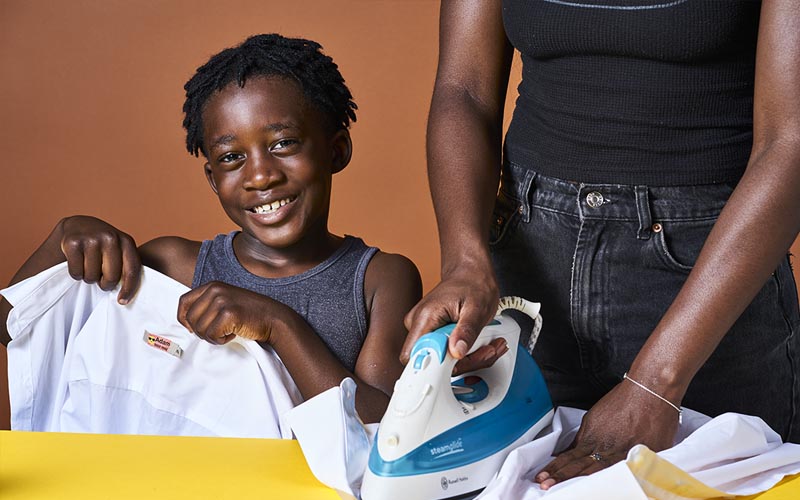
Identifying your children’s possessions is crucial if you’re determined to prevent them from getting lost or mistakenly swapped. But what’s the best option when it comes to personalised labels? When it comes to the debate on iron-on vs sticker name labels, we’ve got the answers you’re looking for.
The iron-on vs stick-on debate is one that many parents struggle with. How do you know which is the best option for your child? Well, it all depends on what you’re labelling and whether or not you plan to pass on the labelled items in the future.
To help you decide, we have taken the time to explain the benefits of both options below. We’ve also answered a few of your most frequently asked questions.

You can settle the iron-on vs sticker name tags debate by thinking about what it is you’re labelling. In short, labelling fabrics — such as PE kits and school jumpers — should always be done with iron-on labels.
These highly durable iron on name labels are applied to a range of fabrics with the use of heat. In effect, iron-on labels are 'melted' onto fabric to ensure they remain in place during the hottest of wash cycles.
There are several advantages to using iron-on vs sticker name tags. For example, they’re highly durable and versatile. Iron-on tags from My Nametags are designed to be washed multiple times, so they should stay in place for the entire life of the garments they identify. And they’re exceptionally easy to apply — a hot iron or hair straightener is all you’ll need.
Most customers in a care home prefer iron on labels for their clothing, as labels for a care home has to withstand very high washing temperatures.
The main disadvantage of iron-on labels is the fact that they’re permanent, which might cause issues if you plan to give the garment to charity or a younger sibling. In addition, iron-on options are only suitable for use on fabrics.

We were presented with the a Queen's Award by HRH King Charles III (then The Prince of Wales) in recognition of bringing quality and innovative products to international markets.

Because of our commitment to first rate service and quality products, we have a near 100% customer satisfaction rating in multiple countries which is unmatched in the nametag market.

Our Colour Name Stickers will stay stuck after being put in the washing machine, dryer, dishwasher, or microwave countless times. Also, there is no need to clean them, they're antimicrobial!

A total of 1.4 million lost school uniforms (354 tonnes of plastic) ends up in landfill each year in the UK (My Nametags, 2020). Help our planet now by labelling to prevent loss.

All iron-on name labels require the application of heat to ensure they ‘melt’ into the fabric and remain there. Most people use a standard domestic iron, but you can also use hair straighteners.
Just remember that iron-on labels “melt” into the fabric of a garment. This design makes them a very reliable solution — but also a permanent one!
A high-quality iron on name label should remain in place and fully legible for as long as the garment is in use. An iron-on label made with premium materials should last forever.
Iron-on name labels are permanent solutions, which means you’ll never be able to remove them without causing damage. If you plan on giving the garment to someone else in the future, choose a stick-on label.
Iron-on name labels are perfect for labelling school clothes such as jumpers, shirts, socks, shorts, blazers, trousers and ties. They’re the practical and fun solution to accidentally swapping garments at school or nursery.
By applying heat to the iron on label, you can ‘melt’ a My Nametags iron-on name label into just about any garment.
Personalised iron on labels can be very high quality these days, My Nametags guarantees that our iron on name labels will stay on in the washing machine for 10 years.
Yes, quality iron on name tags stay on in the washing machine and tumble dryer for longer than the life of the garment. There is no need to use sew in labels any longer.
Stick in labels are very quick and stay on in the wash. They should be put on care labels on clothing, so for socks and similar items without a care label, you may want to use iron-on labels instead.
If you are labelling care home clothing, that is often washed at very high temperatures, you might also be better with personalised iron on care home tags.